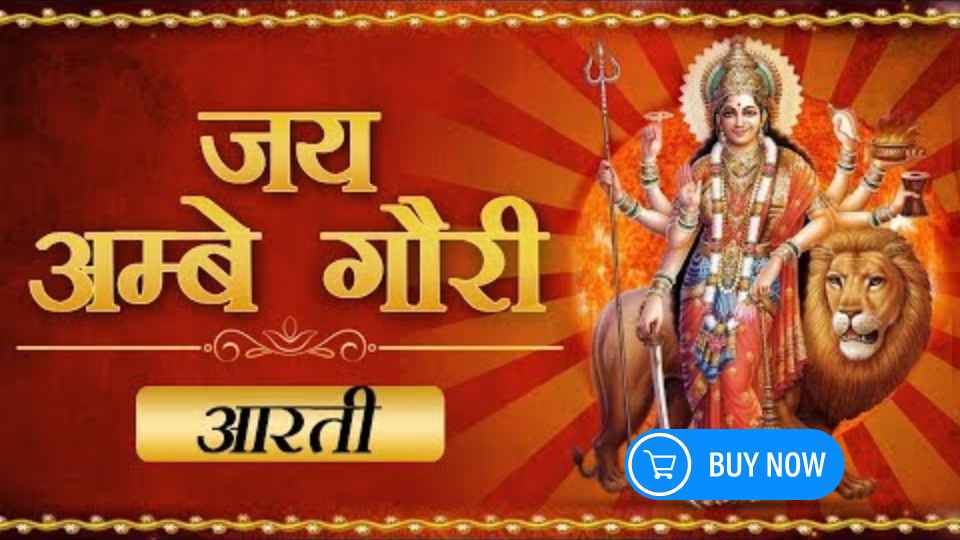In the kaleidoscope of Hindu mythology, there exists a rich tapestry of deities, each with their unique stories, attributes, and devotees. Among these divine beings, one figure stands out with her immense grace, strength, and maternal love – Ambe Gauri, also known as Durga or Parvati. Her presence is celebrated with fervor and devotion across India, especially during the auspicious festival of Navratri. Join me as we delve into the significance and symbolism of Jai Ambe Gauri.

Celebrating the Divine Feminine: जय अम्बे गौरी Buy HERE
दुर्गा जी की आरती: जय अम्बे गौरी, मैया जय अम्बे गौरी… यहां से पढ़ें मां दुर्गा जी की आरती
ॐ जय अम्बे गौरी…
जय अम्बे गौरी, मैया जय श्यामा गौरी ।
तुमको निशदिन ध्यावत, हरि ब्रह्मा शिवरी ॥
ॐ जय अम्बे गौरी..॥
मांग सिंदूर विराजत, टीको मृगमद को ।
उज्ज्वल से दोउ नैना, चंद्रवदन नीको ॥
ॐ जय अम्बे गौरी..॥
कनक समान कलेवर, रक्ताम्बर राजै ।
रक्तपुष्प गल माला, कंठन पर साजै ॥
ॐ जय अम्बे गौरी..॥
केहरि वाहन राजत, खड्ग खप्पर धारी ।
सुर-नर-मुनिजन सेवत, तिनके दुखहारी ॥
ॐ जय अम्बे गौरी..॥
कानन कुण्डल शोभित, नासाग्रे मोती ।
कोटिक चंद्र दिवाकर, सम राजत ज्योती ॥
ॐ जय अम्बे गौरी..॥
शुंभ-निशुंभ बिदारे, महिषासुर घाती ।
धूम्र विलोचन नैना, निशदिन मदमाती ॥
ॐ जय अम्बे गौरी..॥
चण्ड-मुण्ड संहारे, शोणित बीज हरे ।
मधु-कैटभ दोउ मारे, सुर भयहीन करे ॥
ॐ जय अम्बे गौरी..॥
ब्रह्माणी, रूद्राणी, तुम कमला रानी ।
आगम निगम बखानी, तुम शिव पटरानी ॥
ॐ जय अम्बे गौरी..॥
चौंसठ योगिनी मंगल गावत, नृत्य करत भैरों ।
बाजत ताल मृदंगा, अरू बाजत डमरू ॥
ॐ जय अम्बे गौरी..॥
तुम ही जग की माता, तुम ही हो भरता,
भक्तन की दुख हरता । सुख संपति करता ॥
ॐ जय अम्बे गौरी..॥
भुजा चार अति शोभित, खडग खप्पर धारी ।
मनवांछित फल पावत, सेवत नर नारी ॥
ॐ जय अम्बे गौरी..॥
कंचन थाल विराजत, अगर कपूर बाती ।
श्रीमालकेतु में राजत, कोटि रतन ज्योती ॥
ॐ जय अम्बे गौरी..॥
श्री अंबेजी की आरति, जो कोइ नर गावे ।
कहत शिवानंद स्वामी, सुख-संपति पावे ॥
ॐ जय अम्बे गौरी..॥
जय अम्बे गौरी, मैया जय श्यामा गौरी ।
Origins and Legends
The origins and legends surrounding Ambe Gauri are steeped in profound symbolism and emotional depth, reflecting the complexities of human emotions and the cosmic drama of Hindu mythology. Here’s a detailed elaboration on these aspects:
1. Consort of Lord Shiva:
Ambe Gauri is revered as the divine consort of Lord Shiva, the destroyer aspect of the Hindu trinity, alongside Brahma the creator and Vishnu the preserver. As Shiva’s beloved wife, she embodies the feminine energy that complements and harmonizes with his masculine force. Their union represents the cosmic balance between creation and destruction, nurturing and transformation, symbolizing the cyclical nature of existence.
2. Reincarnation of Sati:
The legend of Sati’s self-immolation and subsequent reincarnation as Ambe Gauri is a poignant tale of love, sacrifice, and transcendence. Sati, the daughter of King Daksha, married Shiva against her father’s wishes. In a fit of rage and humiliation, Daksha insulted Shiva in a grand sacrifice ceremony, causing Sati to immolate herself in the sacred fire. Her act of self-sacrifice was not only a demonstration of her unwavering devotion to Shiva but also a protest against societal norms and familial obligations.
3. Shiva’s Cosmic Dance of Destruction:
The news of Sati’s death plunged Shiva into inconsolable grief and fury. In his anguish, he began the Tandava, the cosmic dance of destruction, threatening to annihilate the universe. The intensity of his dance shook the heavens and terrified the gods and demons alike, signaling the impending chaos and destruction.
4. Intervention of Lord Vishnu:
To prevent the catastrophic consequences of Shiva’s fury, Lord Vishnu, the preserver, intervened. He used his Sudarshan Chakra, a divine weapon resembling a spinning discus, to dismember Sati’s body into pieces. Each fragment fell to the earth at different locations, becoming sacred sites known as Shakti Peethas. These sites are revered as potent centers of divine energy and pilgrimage for devotees seeking blessings and spiritual fulfillment.
5. Significance of Shakti Peethas:
The Shakti Peethas hold immense significance in Hindu mythology and religious practices. It is believed that these sites are imbued with the presence of the divine feminine energy, Shakti, in various forms. Devotees visit these sacred places to pay homage to the goddess and seek her blessings for prosperity, protection, and spiritual enlightenment. The story of Sati’s sacrifice and the establishment of the Shakti Peethas serve as a reminder of the eternal bond between the divine and the devotee, transcending the boundaries of life and death.
Symbolism and Attributes
The symbolism and attributes associated with Ambe Gauri are rich with meaning, offering profound insights into her divine nature and role in the cosmic order. Here’s an elaboration on each aspect:
1. Seated on a Lion or Tiger:
Ambe Gauri is often depicted seated on a lion or tiger, both powerful and majestic creatures in Hindu mythology. This imagery symbolizes her embodiment of courage, strength, and protection. The lion or tiger represents her ferocious aspect, signifying her readiness to confront and vanquish the forces of evil and adversity. Additionally, these animals are also associated with royalty and regal authority, highlighting her sovereignty as the divine mother and queen of the universe.
2. Multiple Arms and Weapons:
One of the most distinctive features of Ambe Gauri’s iconography is her multiple arms, each carrying various weapons. These weapons, including swords, tridents, bows, arrows, and maces, symbolize her formidable prowess in combatting negative forces and restoring cosmic balance. Each weapon has its significance, representing different aspects of her power and authority. For example, the sword symbolizes discernment and cutting through ignorance, while the trident signifies her control over the three Gunas – Sattva, Rajas, and Tamas, the qualities that govern human nature and behavior.
3. Trident and Control over Gunas:
The trident (Trishula) wielded by Ambe Gauri holds deep symbolic significance. In Hindu philosophy, the trident represents the three aspects of existence – creation, preservation, and destruction. It also symbolizes her control over the three Gunas, which are fundamental attributes or qualities that characterize all living beings. Sattva represents goodness, purity, and illumination; Rajas signifies passion, activity, and desire; Tamas denotes inertia, darkness, and ignorance. By holding the trident, Ambe Gauri asserts her authority over these primal forces, ensuring the harmony and equilibrium of the universe.
4. Serene Countenance amidst Chaos:
Despite her fearsome appearance and role as a warrior goddess, Ambe Gauri is often depicted with a serene countenance, radiating peace and tranquility. This juxtaposition of ferocity and serenity symbolizes her ability to maintain inner calm and equipoise amidst the chaos and turmoil of battle. It signifies her unwavering devotion to her cosmic duties and her profound connection with the divine. Her tranquil demeanor serves as a reminder to devotees that true strength lies not in outward aggression but in inner peace, wisdom, and spiritual resolve.
Navratri Celebrations
Navratri is a vibrant and joyous festival celebrated with great fervor across India and among Hindu communities worldwide. The festival spans nine nights and ten days, during which devotees worship the divine feminine in her various forms, including Ambe Gauri (Durga), Lakshmi, and Saraswati. Here’s an elaborate exploration of the Navratri celebrations:
1. Devotion to the Divine Feminine:
Navratri is primarily dedicated to the worship of the divine feminine, known as Shakti or Devi, the cosmic energy that pervades the universe. Each night of Navratri is dedicated to a different form of the goddess, representing her various attributes and powers. Devotees invoke her blessings for protection, prosperity, and spiritual enlightenment.
2. Nine Nights of Rituals and Festivities:
During Navratri, devotees observe various rituals and customs to honor the goddess and seek her grace. These include fasting, prayers, meditation, and recitation of sacred hymns and mantras dedicated to the divine mother. Special ceremonies such as Kanya Puja (worship of young girls) and Ghatsthapana (setting up of clay pots representing the goddess) are performed with great reverence.
3. Fasting and Spiritual Purification:
Fasting is an integral part of Navratri observances, with many devotees abstaining from certain foods or following strict dietary restrictions. Fasting is believed to purify the body and mind, enabling devotees to focus their energies on spiritual practices and deepen their connection with the divine. It is also seen as a form of self-discipline and penance.
4. Garba and Dandiya Raas:
One of the highlights of Navratri celebrations is the colorful and energetic folk dances known as Garba and Dandiya Raas. These dances, performed in circles with rhythmic footwork and vibrant costumes, symbolize the joyous celebration of life and the victory of good over evil. Participants dance to traditional folk songs and music, invoking the blessings of the goddess and fostering a sense of community and camaraderie.
5. Durga Puja and Immersion Ceremony:
The culmination of Navratri festivities is marked by Durga Puja, the grand worship of Goddess Durga, also known as Ambe Gauri. Elaborate rituals, including chanting of sacred texts, offering of prayers, and elaborate Aarti ceremonies, are performed to honor the goddess. Idols of Durga, adorned with intricate attire and jewelry, are worshipped with great devotion in beautifully decorated pandals (temporary shrines). The festival concludes with the immersion of Durga idols in rivers or other bodies of water, symbolizing the departure of the goddess and the renewal of life.
Spiritual Significance
The spiritual significance of worshipping Ambe Gauri is profound and multifaceted, resonating deeply with devotees on both personal and universal levels. Here’s an elaboration on each aspect:
1. Triumph of Good over Evil:
The story of Ambe Gauri’s origins and her subsequent battles against demons symbolize the eternal struggle between virtue and vice. Her victory over the buffalo demon Mahishasura, depicted in various Hindu scriptures, represents the triumph of righteousness over malevolence. This aspect of her worship inspires devotees to confront and overcome the negative forces within themselves and in the world around them. It teaches that no matter how daunting the challenges may seem, goodness will ultimately prevail.
2. Light over Darkness:
Ambe Gauri is often depicted with a radiant aura, signifying the presence of divine light dispelling the darkness of ignorance and despair. Her manifestation as Durga, riding a lion or tiger, symbolizes her ability to navigate through the shadows of life’s trials and tribulations fearlessly. By worshipping her, devotees seek to illuminate their minds with the light of knowledge, dispelling ignorance, fear, and confusion. This aspect of her worship encourages seekers to pursue spiritual enlightenment and inner awakening.
3. Knowledge over Ignorance:
In Hindu philosophy, the goddess is considered the embodiment of Shakti, the divine feminine energy that fuels creation, preservation, and destruction. Ambe Gauri’s association with knowledge and wisdom highlights the importance of intellectual and spiritual enlightenment in the pursuit of truth and liberation. Her multiple arms carrying various weapons symbolize her ability to wield the power of discernment and insight to overcome ignorance and delusion. By worshipping her, devotees seek her blessings to attain clarity of thought, understanding, and spiritual realization.
4. Importance of Righteousness, Sacrifice, and Devotion:
The story of Ambe Gauri encompasses themes of righteousness, sacrifice, and devotion. Her incarnation as Sati and her subsequent self-immolation due to her father’s disrespect towards her husband, Shiva, exemplifies the ultimate sacrifice for love and loyalty. This narrative underscores the significance of staying true to one’s principles and values, even in the face of adversity. Additionally, her unwavering devotion to Shiva serves as a model for the profound connection between the devotee and the divine. Through her worship, devotees learn the virtues of selflessness, dedication, and surrender to the divine will.
5. True Strength in Compassion, Wisdom, and Resilience:
Contrary to conventional notions of strength as mere physical power, the worship of Ambe Gauri teaches that true strength emanates from qualities such as compassion, wisdom, and resilience. Despite her ferocious appearance in battle, Ambe Gauri is depicted with a serene countenance, symbolizing inner peace and equanimity. Her ability to balance fierce determination with maternal love underscores the importance of cultivating a harmonious blend of strength and gentleness. By invoking her blessings, devotees seek the fortitude to face life’s challenges with grace, compassion, and unwavering faith.
Celebrating the Divine Feminine: जय अम्बे गौरी Buy HERE

Celebrating the Divine Feminine: जय अम्बे गौरी Buy HERE
दुर्गा जी की आरती: जय अम्बे गौरी, मैया जय अम्बे गौरी… यहां से पढ़ें मां दुर्गा जी की आरती
ॐ जय अम्बे गौरी…
जय अम्बे गौरी, मैया जय श्यामा गौरी ।
तुमको निशदिन ध्यावत, हरि ब्रह्मा शिवरी ॥
ॐ जय अम्बे गौरी..॥
मांग सिंदूर विराजत, टीको मृगमद को ।
उज्ज्वल से दोउ नैना, चंद्रवदन नीको ॥
ॐ जय अम्बे गौरी..॥
कनक समान कलेवर, रक्ताम्बर राजै ।
रक्तपुष्प गल माला, कंठन पर साजै ॥
ॐ जय अम्बे गौरी..॥
केहरि वाहन राजत, खड्ग खप्पर धारी ।
सुर-नर-मुनिजन सेवत, तिनके दुखहारी ॥
ॐ जय अम्बे गौरी..॥
कानन कुण्डल शोभित, नासाग्रे मोती ।
कोटिक चंद्र दिवाकर, सम राजत ज्योती ॥
ॐ जय अम्बे गौरी..॥
शुंभ-निशुंभ बिदारे, महिषासुर घाती ।
धूम्र विलोचन नैना, निशदिन मदमाती ॥
ॐ जय अम्बे गौरी..॥
चण्ड-मुण्ड संहारे, शोणित बीज हरे ।
मधु-कैटभ दोउ मारे, सुर भयहीन करे ॥
ॐ जय अम्बे गौरी..॥
ब्रह्माणी, रूद्राणी, तुम कमला रानी ।
आगम निगम बखानी, तुम शिव पटरानी ॥
ॐ जय अम्बे गौरी..॥
चौंसठ योगिनी मंगल गावत, नृत्य करत भैरों ।
बाजत ताल मृदंगा, अरू बाजत डमरू ॥
ॐ जय अम्बे गौरी..॥
तुम ही जग की माता, तुम ही हो भरता,
भक्तन की दुख हरता । सुख संपति करता ॥
ॐ जय अम्बे गौरी..॥
भुजा चार अति शोभित, खडग खप्पर धारी ।
मनवांछित फल पावत, सेवत नर नारी ॥
ॐ जय अम्बे गौरी..॥
कंचन थाल विराजत, अगर कपूर बाती ।
श्रीमालकेतु में राजत, कोटि रतन ज्योती ॥
ॐ जय अम्बे गौरी..॥
श्री अंबेजी की आरति, जो कोइ नर गावे ।
कहत शिवानंद स्वामी, सुख-संपति पावे ॥
ॐ जय अम्बे गौरी..॥
Conclusion
Jai Ambe Gauri is not merely a goddess but a symbol of divine femininity, embodying the virtues of love, compassion, and empowerment. Through her grace, devotees find solace, courage, and inspiration to navigate the challenges of life. As we chant “Jai Ambe Gauri” with reverence and devotion, let us invoke her blessings and strive to emulate her virtues in our journey towards spiritual enlightenment and inner peace.
Top 20 FAQs about जय अम्बे गौरी
1. What is the significance of celebrating the Divine Feminine, specifically Ambe Gauri (जय अम्बे गौरी)?
The celebration of the Divine Feminine, particularly Ambe Gauri, holds immense significance in Hindu mythology and spiritual practices. Ambe Gauri represents the embodiment of Shakti, the cosmic energy that sustains and nurtures creation. By worshiping her, devotees acknowledge the power of the feminine principle in maintaining cosmic balance and seek her blessings for protection, prosperity, and spiritual enlightenment.
2. When is Navratri celebrated, and why is it important in the worship of Ambe Gauri?
Navratri, meaning “nine nights,” is celebrated twice a year, during the spring (Chaitra Navratri) and autumn (Sharad Navratri) seasons. It is an important festival in the worship of Ambe Gauri and the Divine Feminine in general. During Navratri, devotees observe nine days of fasting, prayers, and rituals dedicated to different forms of the goddess, including Ambe Gauri. It is believed that worshiping the goddess during Navratri brings divine blessings and spiritual merit.
3. How is Ambe Gauri depicted in Hindu iconography, and what do her various attributes symbolize?
Ambe Gauri is typically depicted as a radiant goddess seated on a lion or tiger, wielding multiple arms carrying various weapons such as swords, tridents, and bows. Her lion or tiger symbolizes courage and strength, while her weapons represent her ability to combat evil forces and restore cosmic order. The trident she holds signifies her control over the three Gunas – Sattva, Rajas, and Tamas – the fundamental qualities that govern human nature.
4. What is the significance of the Navratri colors, and why are they important in Ambe Gauri’s worship?
During Navratri, each day is associated with a specific color, representing the different forms and attributes of the goddess. The colors are believed to resonate with the energy of the respective goddess and invoke her blessings. For example, red symbolizes power and action associated with Goddess Durga, while white represents purity and serenity attributed to Goddess Saraswati. Wearing these colors during Navratri is considered auspicious and enhances the efficacy of one’s prayers and devotions to Ambe Gauri.
5. How do devotees observe Navratri, and what are some common rituals performed during this festival?
Devotees observe Navratri by engaging in various rituals and practices to honor the goddess and seek her blessings. These include fasting, daily prayers, recitation of sacred texts such as the Durga Saptashati, and participation in cultural events such as Garba and Dandiya Raas. Special ceremonies like Kanya Puja, where young girls are worshipped as embodiments of the divine feminine, are also performed during Navratri.
6. What is the significance of the Durga Puja ceremony, and how is it conducted during Navratri?
Durga Puja is the grand worship of Goddess Durga, also known as Ambe Gauri, during Navratri. It involves elaborate rituals, including bathing the idol, offering prayers, chanting of mantras, and performing Aarti ceremonies. Devotees adorn the goddess with exquisite attire and jewelry and offer various offerings such as flowers, fruits, and sweets. The Durga Puja ceremony concludes with the immersion of Durga idols in water bodies, symbolizing the departure of the goddess and the renewal of life.
7. Why are clay pots (Ghatsthapana) set up during Navratri, and what is their significance in Ambe Gauri’s worship?
Clay pots, known as Ghatsthapana, are set up during Navratri as part of the rituals dedicated to Ambe Gauri. These pots symbolize the womb of the goddess and are filled with water and seeds, representing fertility and abundance. Devotees worship the Ghatsthapana daily, offering prayers and performing rituals to invoke the blessings of the goddess for prosperity and well-being.
8. What are the spiritual teachings and lessons associated with the worship of Ambe Gauri?
The worship of Ambe Gauri imparts various spiritual teachings and lessons to devotees. It emphasizes the importance of recognizing the divine feminine energy within oneself and in the world around. Ambe Gauri teaches virtues such as courage, compassion, and resilience and encourages devotees to overcome obstacles and adversities with faith and determination. Her worship also fosters a sense of devotion, surrender, and gratitude towards the divine.
9. How does the story of Sati and her reincarnation as Ambe Gauri relate to the worship of the Divine Feminine?
The story of Sati and her reincarnation as Ambe Gauri highlights the transformative power of the divine feminine and the eternal bond between the goddess and her devotees. Sati’s sacrifice and subsequent rebirth symbolize the cyclical nature of life, death, and rebirth and the enduring love and devotion between the divine couple, Shiva and Parvati. Through her story, devotees learn the importance of selflessness, sacrifice, and unwavering devotion in their spiritual journey.
10. What are some traditional offerings made to Ambe Gauri during Navratri, and what is their significance?
Devotees offer various items to Ambe Gauri during Navratri as a gesture of devotion and gratitude. These offerings include flowers, especially marigolds and red hibiscus, which symbolize purity and auspiciousness. Fruits such as bananas and coconuts are also offered as symbols of fertility and abundance. Additionally, sweets like jaggery and modaks are offered to the goddess as symbols of sweetness and divine blessings.
11. How does the worship of Ambe Gauri during Navratri promote spiritual growth and self-transformation?
The worship of Ambe Gauri during Navratri offers devotees an opportunity for spiritual growth and self-transformation. Through fasting, prayers, and other devotional practices, devotees purify their minds and bodies, cultivate virtues such as patience, discipline, and compassion, and deepen their connection with the divine. The goddess’s grace and blessings empower devotees to overcome their weaknesses and challenges and embark on the path of self-realization and enlightenment.
12. What role do Garba and Dandiya Raas play in Navratri celebrations, and how do they honor Ambe Gauri?
Garba and Dandiya Raas are traditional folk dances performed during Navratri as part of the festive celebrations. These dances are dedicated to the worship of Ambe Gauri and invoke her blessings for prosperity and happiness. Garba involves dancing in circular formations around an earthen lamp (Garba) symbolizing the divine presence, while Dandiya Raas involves rhythmic movements with sticks, symbolizing the playful interactions between the divine couple, Shiva and Parvati. Through these dances, devotees express their joy and devotion to the goddess and celebrate the spirit of Navratri with enthusiasm and fervor.
13. How do devotees prepare for Navratri, and what are some common pre-festival rituals?
Devotees prepare for Navratri by cleaning and decorating their homes, setting up altars or puja rooms, and making arrangements for fasting and prayers. Special attention is given to selecting appropriate attire and accessories, including traditional dresses in Navratri colors, and organizing cultural events and performances. Additionally, devotees may undertake spiritual practices such as reciting mantras, reading sacred texts, and seeking the guidance of spiritual mentors to prepare themselves mentally and emotionally for the festive celebrations.
14. What is the significance of the number nine in Navratri, and how does it relate to the worship of Ambe Gauri?
The number nine holds great significance in Navratri, as the festival spans nine nights and is dedicated to the worship of nine different forms of the goddess. These nine forms, known as Navadurga, represent the various attributes and powers of the divine feminine. Each night of Navratri is associated with a specific form of the goddess, and devotees offer prayers and perform rituals to honor her divine manifestations. The worship of Ambe Gauri, one of the forms of Navadurga, symbolizes the culmination of Navratri celebrations and the culmination of divine blessings and spiritual merit.
15. What are some common chants and hymns recited during Navratri, and how do they glorify Ambe Gauri?
Devotees recite various chants and hymns dedicated to Ambe Gauri and the divine feminine during Navratri, invoking her blessings and grace. Some common chants include the Durga Saptashati (also known as the Devi Mahatmya), a sacred text describing the exploits of Goddess Durga in vanquishing the demon Mahishasura, and the Navratri Mantras, which praise the different forms of the goddess and seek her divine blessings for protection and prosperity. These chants are believed to have immense spiritual potency and help devotees establish a deep connection with the divine mother.
16. How does the worship of Ambe Gauri during Navratri promote gender equality and empower women?
The worship of Ambe Gauri during Navratri promotes gender equality and empowers women by celebrating the divine feminine as the embodiment of strength, wisdom, and compassion. Through rituals like Kanya Puja, where young girls are worshipped as manifestations of the goddess, Navratri honors and uplifts the feminine spirit and acknowledges the important role of women in society. By venerating Ambe Gauri as the supreme goddess, Navratri fosters a culture of respect, reverence, and equality towards women and inspires them to embrace their innate divinity and potential.
17. What are some traditional stories and legends associated with Ambe Gauri, and how do they inspire devotion and reverence?
Ambe Gauri is associated with numerous stories and legends that inspire devotion and reverence among devotees. These include the story of her incarnation as Sati, her marriage to Lord Shiva, her victory over the buffalo demon Mahishasura, and her role as the divine mother protecting and nurturing creation. Through these stories, devotees learn about Ambe Gauri’s compassion, courage, and wisdom and find inspiration in her divine exploits and benevolent grace.
18. How does the worship of Ambe Gauri during Navratri foster a sense of community and social harmony?
The worship of Ambe Gauri during Navratri fosters a sense of community and social harmony by bringing people together in collective worship and celebration. Navratri events and gatherings provide opportunities for people from diverse backgrounds to come together, regardless of caste, creed, or social status, and unite in their devotion to the goddess. Through rituals like Garba and Dandiya Raas, people engage in joyful communal activities, forging bonds of friendship, solidarity, and mutual respect. Navratri thus serves as a powerful platform for promoting social cohesion, cultural exchange, and interfaith harmony.
19. How do modern-day celebrations of Navratri and the worship of Ambe Gauri reflect cultural diversity and creativity?
Modern-day celebrations of Navratri and the worship of Ambe Gauri reflect cultural diversity and creativity through innovative rituals, events, and performances. While traditional customs and practices are observed with reverence, Navratri celebrations also incorporate contemporary elements such as music concerts, dance competitions, and fashion shows, catering to the diverse interests and preferences of devotees. Additionally, cultural fusion and exchange are encouraged, with people from different communities coming together to celebrate Navratri in unique and inclusive ways, thereby enriching the cultural tapestry of society.
20. How can one deepen their devotion to Ambe Gauri and integrate her teachings into their daily life beyond Navratri?
To deepen their devotion to Ambe Gauri and integrate her teachings into their daily lives beyond Navratri, one can cultivate a regular spiritual practice that includes prayers, meditation, and acts of service. Reading and reflecting on sacred texts related to the goddess, such as the Durga Saptashati and the Devi Bhagavatam, can deepen one’s understanding of her divine attributes and inspire greater devotion. Additionally, performing selfless acts of kindness and compassion, honoring the feminine within oneself and others, and seeking to embody the virtues of courage, wisdom, and resilience exemplified by Ambe Gauri can help devotees forge a deeper and more meaningful connection with the divine mother in their everyday lives.
Celebrating the Divine Feminine: जय अम्बे गौरी Buy HERE

Celebrating the Divine Feminine: जय अम्बे गौरी Buy HERE
Register for My Upcoming Masterclass HERE
See You in the Live Masterclass
Sunil Chaudhary stands as a preeminent global Leading digital coach, boasting a diverse clientele hailing from over 50 nations. Renowned for his prowess as an exemplary SEO expert, business automation coach, and landing page authority, Chaudhary also holds the distinction of being esteemed as the finest business coach in India. Beyond technical domains, he imparts invaluable insights into mindset, success, and life skills, thus encompassing a holistic approach to mentorship.
Join FREE Courses HERE
Know The Author:
 Sunil Chaudhary aka Suniltams Guruji is India’s Leading Digital Coach. He provides complete Digital Skill Development Coaching with great support. Sunil has trained more than 25000 students and helped more than 1100 businesses so far. Sunil is a well-known face across the world for Digital Coaching.
Sunil Chaudhary aka Suniltams Guruji is India’s Leading Digital Coach. He provides complete Digital Skill Development Coaching with great support. Sunil has trained more than 25000 students and helped more than 1100 businesses so far. Sunil is a well-known face across the world for Digital Coaching.
Digital Success Coach | Best SEO Coach India | Mindset Coach | Life Success Coach





